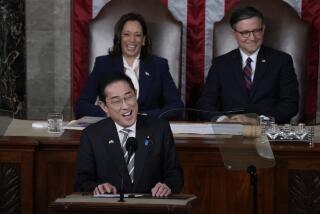How a Humbled Nation Revived--a Chronology
- Share via
These are major dates in Japan’s postwar history:
1945: Atomic bombs are dropped on Hiroshima on Aug. 6 and on Nagasaki on Aug. 9--at a late stage of World War II when more than half of the Japanese economy has been destroyed, arms spending consumes more than 80% of the budget and 2,517,406 Japanese (including 658,595 civilians) have been killed. Japan surrenders, and Emperor Hirohito on Aug. 15 orders the Japanese people to “endure the unendurable and suffer the insufferable” of an American occupation. Japan’s armed forces are dismantled, and all military production, including aircraft construction, is banned.
1946: Hirohito tells his people that he has never been a god, contrary to claims by Japanese militarists, and for the first time, he mingles with his people during a series of inspections of war damage throughout the country. Women win the right to vote for the first time--in the first postwar general election.
1947: A new “peace constitution” comes into effect renouncing war as a sovereign right of the nation, banning the threat or use of force as a means of settling international disputes, and outlawing the maintenance of land, sea and air forces, as well as other war potential.
1950: The Korean War begins. American military procurement revitalizes Japan’s economy. The National Police Reserves, the predecessor of the postwar Self-Defense Forces, are established.
1952: The San Francisco peace treaty, boycotted by Communist nations, takes effect, and the American occupation ends. Japan becomes an American ally as a security treaty between the two nations, giving American forces stationed in Japan the right to put down domestic insurrection, also takes force.
1954: Ground, maritime and air Self-Defense Forces are established.
1955: The Japanese economy recovers to a level equal to the peak prewar gross national product of 1939. Conservatives regroup and form the Liberal Democratic Party, beginning a 30-year unbroken rule of the nation.
1956: Japan and the Soviet Union end their formal state of war and agree to establish diplomatic relations. Moscow drops its veto, and Japan joins the United Nations. Japan surpasses Britain in shipbuilding output.
1960: The U.S.-Japanese security treaty is revised, eliminating the U.S. right to intervene in domestic Japanese politics, but demonstrations against the government of Prime Minister Nobusuke Kishi and the alliance with the United States force cancellation of a visit by President Dwight D. Eisenhower three days before his scheduled arrival. Hayato Ikeda succeeds Kishi as prime minister, with a plan to double incomes in 10 years, and Japan embarks upon double-digit annual growth.
1964: The Olympic Games are held in Tokyo, symbolizing Japan’s full-fledged return to international society, and the influx of money spells the end of a long period of poverty. Japan joins the International Monetary Fund.
1965: Japan registers the first of what are to become continuous annual trade surpluses with the United States. Diplomatic relations are established with South Korea, officially closing the breach created by Japan’s 1910-45 occupation and colonization of Korea.
1968: Japan surpasses West Germany in GNP. The United States returns Iwo Jima and the Ogasawara (Bonin) island group to Japan’s control.
1970: The country’s first international exposition is staged for six months in Osaka, marking achievement of a goal set in the mid-19th Century to “catch up with the West.” It heralds a Japanese age of affluence.
1971: Hirohito becomes the first emperor ever to leave Japan during his reign, retracing steps of a 1921 tour to Europe as crown prince that he considers his most cherished memory. Until the 1921 trip, he recalled, “I was living a life like a bird in a cage.”
1972: The United States returns Okinawa to Japanese control, ending 27 years of American military rule of the island prefecture (state). China and Japan establish diplomatic relations, easing tension over the U.S. security treaty, which leftists had charged was an obstacle to friendly relations with Japan’s ancient cultural mentor. From this time on, protests over American bases in Japan subside.
1974: Gerald R. Ford becomes the first U.S. President ever to visit Japan while in office. Prime Minister Kakuei Tanaka resigns in the wake of accusations of illicit financial dealings and begins a role as a behind-the-scenes political power broker.
The oil crisis pushes Japan’s inflation above 20%, spurs wage increases of more than 30% and creates the only decline (a drop of 1.2%) in the gross national product during the postwar period. Entrepreneurs, however, begin investments in energy-saving and efficiency-improving equipment that will in time make Japan economically stronger than before the crisis.
1975: Emperor Hirohito visits the United States and expresses regret for “the most unfortunate war.”
1976: Tanaka is arrested on a charge of accepting a $1.8-million Lockheed Aircraft Corp. bribe. Japan’s trade surplus with the United States surpasses $5 billion for the first time.
1978: The U.S. trade surplus tops $10 billion.
1979: The Japanese economy passes the $1-trillion mark.
1980: Japan surpasses the United States in passenger-car production, 7,038,108 vs. 6,375,506, and in steel production, 111.4 million tons vs. 101.5 million tons.
1982: Honda becomes the first Japanese automaker to start production of passenger cars in the United States. Prime Minister Yasuhiro Nakasone takes office, with Tanaka’s support.
1985: Tanaka, convicted in 1983 on the Lockheed bribery charge, suffers a stroke and disappears from the political scene, leaving Nakasone with a free hand. Hirohito, 84, becomes Japan’s oldest emperor. Japan’s trade surplus with the United States heads toward $50 billion.
More to Read
Sign up for Essential California
The most important California stories and recommendations in your inbox every morning.
You may occasionally receive promotional content from the Los Angeles Times.













